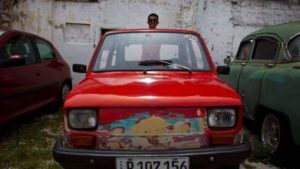 A HUMBLE Polish two-cylinder car rear door, the Fiat 126p was forgotten by most people after the fall of the Berlin Wall. Decades later, this car affectionately known on the island as Polski, lives a new era in Cuba.
A HUMBLE Polish two-cylinder car rear door, the Fiat 126p was forgotten by most people after the fall of the Berlin Wall. Decades later, this car affectionately known on the island as Polski, lives a new era in Cuba.
Cuts to subsidized oil from Venezuela, people complain about the lack of buses and taxis on the streets. The average wage is about $ 25 per month, and the price of cars _ _ controlled by the government and naphtha are among the highest in the world.
The Polski is equipped with disc brakes, new tires, a box of improved speed and an engine almost twice as powerful as the original.
The Polish engine often get so hot that many owners in Cuba circulate with the back door open to try out the hot air from the machine. (Agencies/El Clarin/Internet Photos/Arnoldo Varona, TheCubanHistory.com)
 THIS IS the photo of one of the tunnels where the Soviets installed the rockets that caused the then called Missile Crisis between Cuba, the URSS and the USA. The rockets were stationed in the vicinity of a sugar mill. It was not known well what they were or where they were, until the US spy flights made some photos on 17 October 1962. “MRBMs Field Launch Site, Sagua la Grande # 2,” the foot of the famous stamp. The missiles aimed from the shade of a palm grove.
THIS IS the photo of one of the tunnels where the Soviets installed the rockets that caused the then called Missile Crisis between Cuba, the URSS and the USA. The rockets were stationed in the vicinity of a sugar mill. It was not known well what they were or where they were, until the US spy flights made some photos on 17 October 1962. “MRBMs Field Launch Site, Sagua la Grande # 2,” the foot of the famous stamp. The missiles aimed from the shade of a palm grove.
Mariana Grajales is called the center. They demolished it a few years ago. It is far from the busiest roads, about 15 kilometers from Sagua la Grande. Factory where there was a vacant lot. People prefer to sit near the store, the sombra.Esta is the best image of the Cuban Missile Crisis or Missile Crisis: a crowd dances after a rocket props, while Kennedy decreed the near maximum emergency and Americans get into basements. In Cuba there was no 17-minute televised panic. Neither the peasants knew what nuclear war era. Nor they were explained.
(Agencies/DDC/GonzalezViveroPhotos/Arnoldo Varona, The CubanHistory.com)


